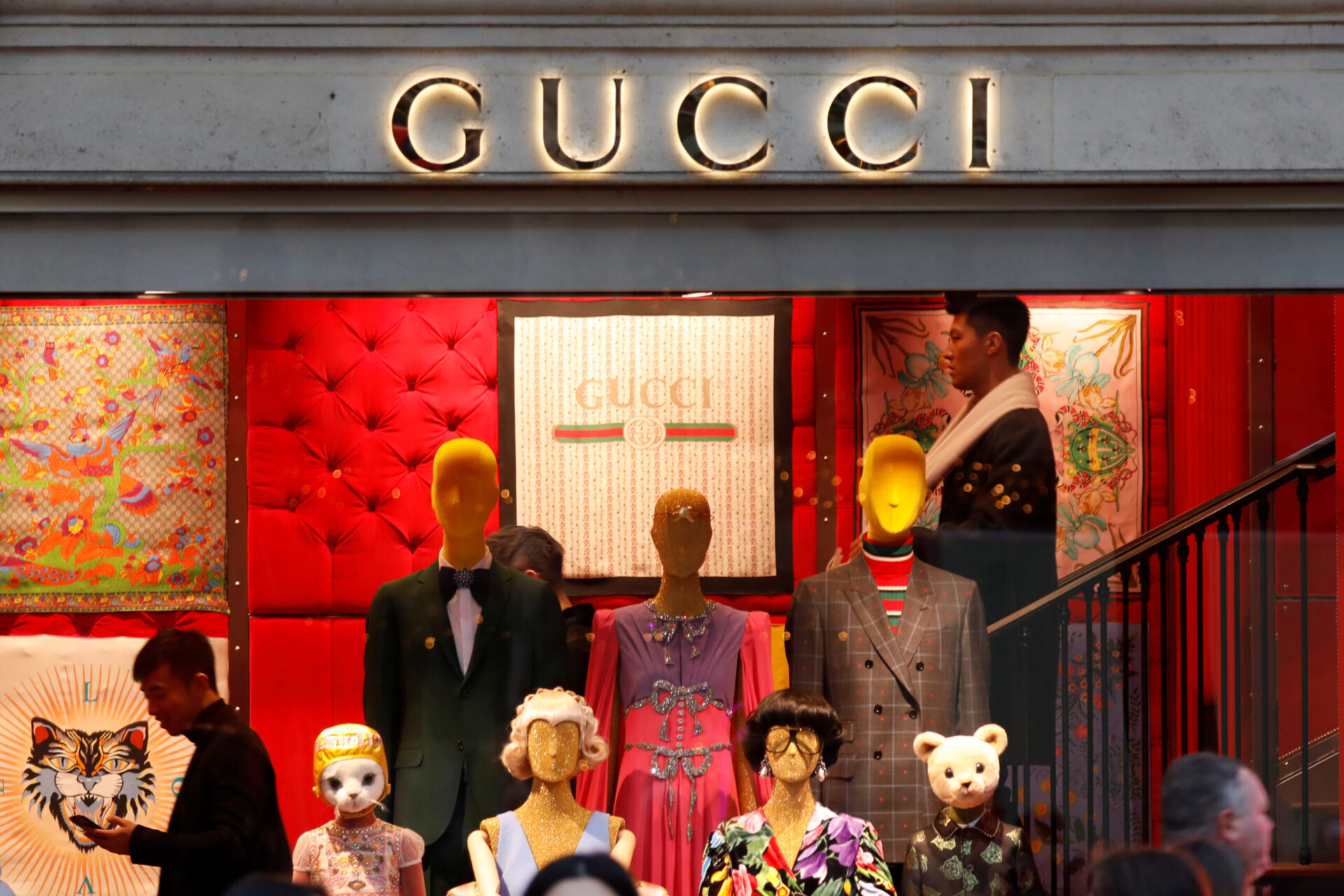Gucci, the renowned Italian luxury fashion house headquartered in Florence, Italy, is a name synonymous with opulence and style. Established in 1921 by Guccio Gucci, it has evolved into a global fashion icon offering a wide range of products, including handbags, ready-to-wear clothing, footwear, accessories, and even home decor items. Gucci has extended its brand influence by licensing its name and image to Coty for its fragrance and cosmetics line, known as Gucci Beauty.
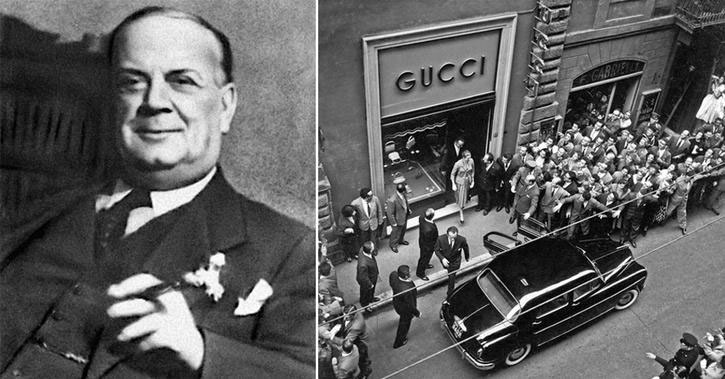
The journey of Gucci is a fascinating one. Founded in the heart of Florence, Tuscany, by Guccio Gucci, it grew under the leadership of his son, Aldo Gucci, to attain worldwide recognition, becoming a symbol of the Italian “dolce vita” or sweet life era. However, amidst family disputes in the 1980s, the Gucci family lost control of the company by 1993. This tumultuous period served as a turning point.
In 1999, Gucci underwent a revival when it was acquired by the French conglomerate PPR, which later rebranded as Kering. Under the leadership of CEO Marco Bizzarri, who assumed the position in December 2014, and the creative direction of Alessandro Michele from January 2015 to November 23, 2022, Gucci experienced a renaissance. Alessandro Michele’s innovative approach and eclectic style resonated with a new generation of fashion enthusiasts, cementing Gucci’s status as a pioneering brand.
Today, Sabato De Sarno has taken the helm as the current creative director, ushering in a new era of creativity and innovation for Gucci. Till 2022, Gucci boasted 528 stores worldwide, employed over 21,000 individuals, and achieved a remarkable €10.9 billion in sales, reflecting substantial growth compared to its €9.73 billion in sales in 2021. This financial success underscores Gucci’s enduring appeal and its ability to connect with a global audience.

Success Story of Gucci
Gucci’s Birth in 1921: From London to Florence
The origins of Gucci are deeply intertwined with the rich heritage of Florence, a city known for its artistic and merchant traditions dating back to the early 15th century. Guccio Gucci (1881–1953), the visionary founder of Gucci, had his roots firmly planted in this historic city.
Guccio Gucci’s journey began when he left Florence and ventured to Paris before eventually settling in London in 1897. In London, he secured a position at the prestigious Savoy Hotel. As a bellhop at the Savoy, Guccio’s responsibilities included handling the luggage of the hotel’s affluent clientele. It was during this time that he keenly observed their preferences for fashion, quality, fabrics, and the importance of comfortable travel.
Guccio’s pursuit of knowledge continued as he spent four years working for the Compagnie des Wagons-Lits, a European rail company renowned for providing upscale travel experiences. This experience further enriched his understanding of luxurious travel lifestyles.
Following World War I, Guccio Gucci found employment with Franzi, a renowned manufacturer of fine luggage. This role allowed him to delve deeper into the world of high-quality luggage craftsmanship.
In 1921, Guccio Gucci took a significant step by establishing his own shop on Via della Vigna Nuova in Florence, known as Azienda Individuale Guccio Gucci. At this shop, he initially specialized in the sale of imported leather luggage. To bring his creative vision to life, he also set up a small workshop, where local artisans crafted leather goods according to his designs. As demand for Gucci’s products grew, a larger workshop was acquired to accommodate a team of sixty skilled artisans.
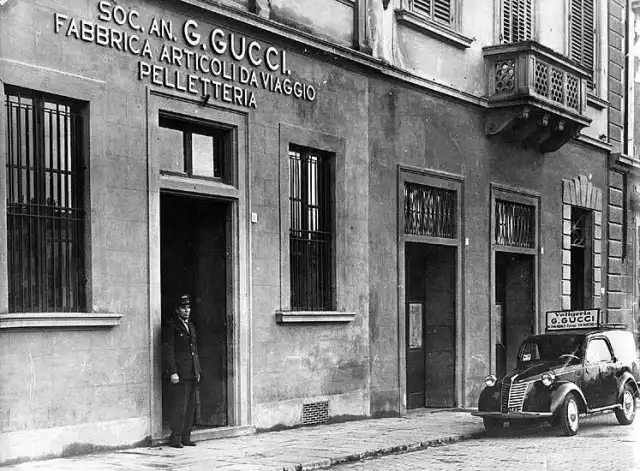
The year 1935 posed a unique challenge when Mussolini’s invasion of Ethiopia led to a trade embargo imposed on Italy by the League of Nations. This embargo resulted in a scarcity of leather, prompting Guccio Gucci to explore alternative materials for his products. Raffia, wicker, wood, linen, and jute were incorporated into the product range. During this period, the iconic rombi motif, now synonymous with Gucci, was conceived. Gucci also developed an innovative tanning technique, giving rise to “cuoio grasso,” which quickly became a hallmark of the brand. In 1937, Gucci introduced its collection of handbags, marking a significant milestone in its journey.
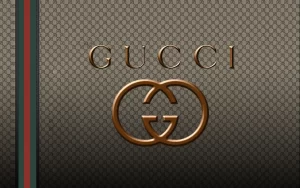
The Gucci family played a pivotal role in the brand’s development. Guccio’s wife and children actively contributed to the shop’s success. His son, Aldo, who joined the family business in 1925, played a key role in its expansion. He persuaded his father to open a new boutique in Rome, specifically at 21 Via Condotti, in 1938. Under Aldo’s guidance, Gucci diversified its product offerings to include accessories like gloves, belts, wallets, and keychains.
World War II brought new challenges, leading the skilled artisans at Gucci to shift their focus to producing boots for the Italian infantry, demonstrating the brand’s adaptability during trying times.
In the midst of the war, due to material shortages, Gucci began crafting handbags from cotton canvas instead of leather. These canvas bags bore a distinctive double-G symbol, complemented by prominent red and green bands. This iconic design would go on to define Gucci’s identity.
After the war, the Gucci crest, featuring a shield and an armored knight encircled by a ribbon inscribed with the family name, became an enduring symbol closely associated with the city of Florence and the brand’s legacy.
The Post-War Renaissance of Gucci
Following the challenging years of World War II, Gucci’s founder, Guccio Gucci, undertook a strategic move that would shape the brand’s future. In a forward-thinking gesture, he distributed shares of the company among his three sons: Aldo, Vasco, and Rodolfo. This marked the beginning of a new era for the brand.
In 1947, Gucci introduced a groundbreaking creation that would become a timeless classic—the Bamboo bag. This iconic piece showcased Gucci’s commitment to innovation and craftsmanship.
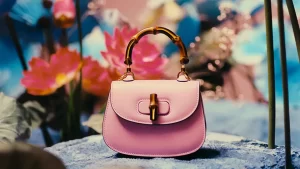
The year 1952 witnessed the debut of the Gucci loafer, also known as the moccasin. This design would go on to achieve legendary status in the world of fashion.
Sadly, Guccio Gucci passed away on January 2, 1953, in Milan, but his legacy lived on through his sons.
In November 1953, Gucci embarked on its international journey by opening its first store in the United States. Located on 5th Avenue and 58th Street in New York, this move marked a significant expansion for the brand. It was followed by the opening of a second store in the Saint Regis Hotel in 1960 and a third on 5th Avenue and 54th Street in 1973. This cluster of Gucci boutiques led locals to affectionately dub the area “Gucci City.”
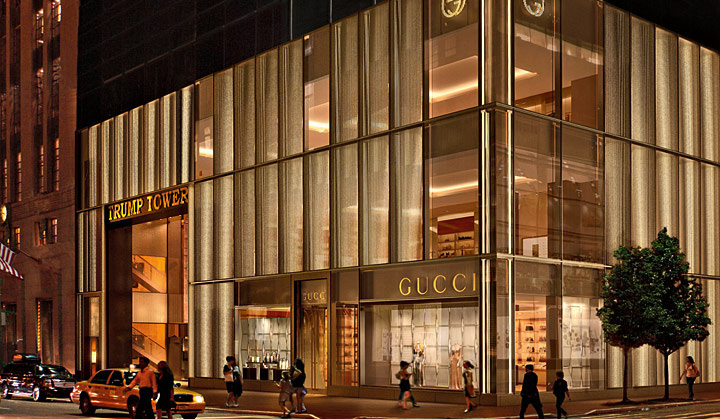
Gucci continued to spread its influence globally. In 1961, stores were established in London and Palm Beach, and the iconic Jackie Bag made its debut. The brand’s presence in the fashion capital of the world was solidified when Gucci opened its first store near Place Vendôme in Paris in March 1963.
In 1964, the distinctive double-G logo, which would later become synonymous with Gucci, was introduced for belt buckles and other accessory decorations.
The year 1966 witnessed the creation of the Flora scarf, designed by Rodolfo Gucci and Vittorio Accornero for Grace Kelly, Princess of Monaco. Her endorsement of Gucci products catapulted the brand to new heights.
By October 1968, Gucci had set up shop at 347 Rodeo Drive, attracting Hollywood stars and launching its first line of dresses. This breakthrough in the United States paved the way for global expansion, including ventures in Asia (with a Tokyo store opening in 1972 and Hong Kong in 1974) and the Middle East.
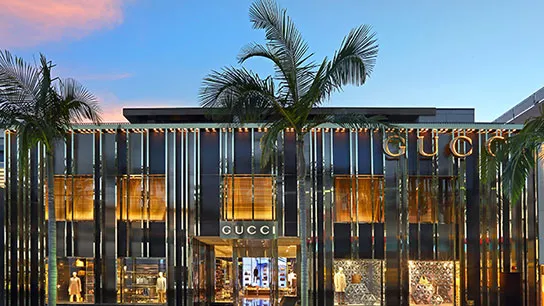
Aldo’s son, Roberto, played a pivotal role by overseeing the first Gucci franchised store in Brussels.
By 1969, Gucci managed ten stores in the United States alone, and the brand’s moccasins became a sensation, with a staggering 84,000 pairs sold in the US during that year. The brand’s influence was such that even US President John F. Kennedy referred to Aldo Gucci as the “first Italian ambassador to the United States.”
In 1970, Gucci took a unique step by launching a luxurious Rolls-Royce luggage set, showcasing its commitment to travel elegance. Additionally, Gucci partnered with American Motors Corporation (AMC) to create the Gucci version of the AMC Hornet, a collaboration that marked a fusion of automotive and fashion luxury.
The year 1972 saw Gucci’s expansion into the realms of fragrances with the introduction of Gucci Perfumes (Il Mio Profumo) and the unveiling of its first watch, the Model 2000. This period also witnessed the opening of the first franchised Gucci store in the United States in 1973. Moreover, Gucci established the Gucci Galleria within its Beverly Hills store in 1977, a private art gallery exclusively accessible to premium clients holding a golden key.
From 1978 to 1984, a Miami-based coachbuilder offered a Gucci edition of the Cadillac Seville sedan, showcasing the brand’s influence even in the automotive world. Notably, the 1978 model is now displayed at the Gucci Museum.
In 1985, a testament to Gucci’s enduring appeal and impact on fashion, the Gucci loafer earned a place in the permanent collection of the New York Museum of Modern Art (MoMA). This recognition solidified Gucci’s status as a fashion icon.
Gucci’s journey, marked by innovation, expansion, and creative collaborations, had firmly established it as a global leader in luxury fashion. But the brand’s story was far from over, with more remarkable chapters yet to be written.
1980s: Gucci’s Family Feud and Rebuilding
The 1980s brought significant changes and challenges to Gucci, marked by family disputes and efforts to restore the brand’s exclusivity.
In 1969, Giorgio, Aldo’s son, sparked the first family feud by launching Gucci Boutique independently. However, the boutique was eventually reabsorbed into the family group in 1972. The 1980s saw tensions within the Gucci family escalate. Paolo Gucci, another son of Aldo, attempted to launch the brand “Gucci Plus” on his own. Aldo, criticized for focusing on international business through Gucci America, which he owned, found himself at the center of controversy.
To mitigate family conflicts and stabilize the brand, the Gucci group was consolidated in 1982 and became a publicly-traded company known as Guccio Gucci SpA. Tragically, in May 1983, Rodolfo Gucci passed away, leaving his son, Maurizio Gucci, with a majority stake in the company. This led to a legal battle between Maurizio and his uncle Aldo for full control of Gucci, with the legal proceedings involving notable figures like Rudolph Giuliani and Domenico de Sole.
Maurizio Gucci ultimately assumed leadership of the company. However, his management was marred by financial challenges. Between 1991 and 1993, Gucci faced financial difficulties, partly attributed to extravagant spending on headquarters in Florence and Milan.
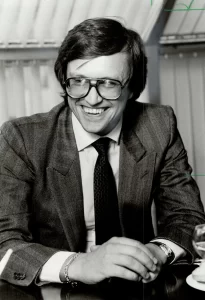
In 1993, Investcorp purchased the remaining 50% of Guccio Gucci S.p.A. from Maurizio Gucci, effectively ending the family’s involvement in the brand. Tragedy struck in March 1995 when Maurizio Gucci was fatally shot in the lobby of Gucci’s Milan office. His ex-wife, Patrizia Reggiani, was convicted of hiring a hitman to carry out the murder and served 16 years in prison.
The Dawn of a New Era: The Arrival of Dawn Mello and Tom Ford
In November 1989, Gucci brought in Dawn Mello as the executive vice president and chief designer. Mello initiated a strategy to restore Gucci’s exclusivity. She reduced the number of stores from over 1,000 to 180 and streamlined the product range from 22,000 to 7,000 items.
Under Mello’s guidance, iconic Gucci pieces like the Bamboo bag and the Gucci loafer were revived. The brand’s headquarters were moved back to Florence, honoring its deep-rooted history.
Dawn Mello made a pivotal decision by appointing Tom Ford to oversee the women’s ready-to-wear collection. In 1994, Tom Ford was named the creative director of Gucci. Ford and Mello revisited the brand’s 1970s archives and introduced a fresh and provocative collection in 1995, featuring sensual white dresses with daring cut-outs.
Gucci’s revival was marked by unique and provocative limited-edition products, such as silver handcuffs and even a G-string. These bold moves not only generated attention but also contributed to the brand’s resurgence.
Domenico De Sole and Gucci’s Financial Reinvention
Domenico De Sole, who had been advising the Gucci family since the 1980s, assumed the role of CEO of Gucci in 1994. He played a crucial role in rejuvenating the brand’s financial health. De Sole fostered strong partnerships with Gucci’s leather manufacturers in Italy and implemented a partners’ program to strengthen their collaboration.

He also carefully assessed the pricing of each product and significantly increased Gucci’s advertising budget from $6 million in 1993 to $70 million in 1997.
In October 1995, Gucci went public on the New York Stock Exchange, marking a significant milestone in the brand’s history.
During this period, Investcorp gradually sold its interests in Gucci for approximately US$1.9 billion from 1995 to 1997, signaling the brand’s growth and profitability.
LVMH-PPR Struggle over Gucci
In January 1999, the French luxury conglomerate LVMH began quietly acquiring shares of Gucci, ultimately reaching 34% ownership in Gucci Group NV by 2000. Seeking to regain control, Tom Ford and Domenico De Sole turned to French financier François Pinault and his group Pinault Printemps Redoute (later known as Kering) for assistance.
In March, Pinault’s group acquired 40% of Gucci at $75 a share, reducing LVMH’s shares to 20.7% in a dilution process. As part of the deal, PPR also acquired Yves Saint Laurent from Sanofi and sold it back to the Gucci Group.
This move led to a feud between LVMH and the new Gucci-PPR alliance, culminating in a tense moment in December 2000 when Gucci purchased 51% of Alexander McQueen’s couture house, a brand also affiliated with LVMH.
The feud was resolved in September 2001 when all parties reached an agreement. By the end of 2003, Tom Ford and Domenico De Sole announced they would not renew their contract with Gucci-PPR, which ended in April 2004.
A New Chapter: Post-Tom Ford Gucci
Following Tom Ford’s departure, Gucci Group retained several designers to continue the brand’s success. These designers included John Ray, Alessandra Facchinetti, and Frida Giannini, all of whom had worked under Ford’s creative direction.
Frida Giannini, who had been with Gucci since 2002, was appointed creative director of Gucci in 2006. She gradually transitioned Gucci from Ford’s ‘Porno Chic’ era to a more sensual and androgynous style.

Patrizio di Marco became Gucci’s CEO in 2008, focusing on offering fewer styles and introducing more midrange products.
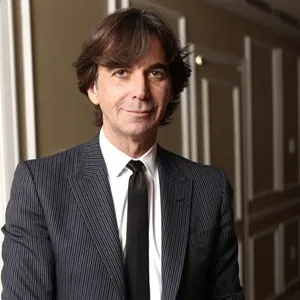
Between 2010 and 2015, Gucci embarked on an ambitious expansion plan, opening 220 new stores worldwide, bringing the total store count to 500.
The Renaissance of Gucci: Alessandro Michele Takes the Helm
In December 2014, Marco Bizzarri, former CEO of Bottega Veneta, was appointed as Gucci’s CEO. He faced the challenge of reviving Gucci’s declining sales and breathing new life into the brand.
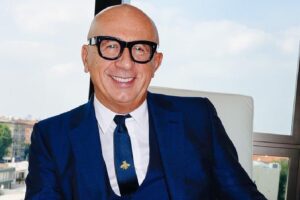
In January 2015, Bizzarri appointed Alessandro Michele as the creative director of Gucci. Michele, who had been with Gucci since 2002, brought a fresh perspective to the brand, characterized by a “sophisticated, intellectual, and androgynous feel.”
Alessandro Michele initiated the Renaissance of Gucci by revisiting classics like the double-G logo, the Jackie O. bag, and introducing iconic products like the Dionysus handbag.
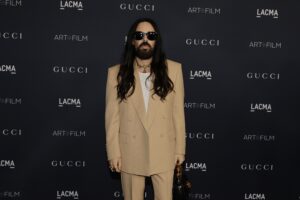
Under Michele’s direction, Gucci embraced a ‘geek-chic’ style with feminist undertones, introducing postgender props and challenging conventional norms.
Gucci’s Ongoing Success and Expansion
In the years that followed, Gucci continued to thrive. The brand inaugurated the Gucci Hub, its new Milan headquarters, in September 2016. Gucci’s expansion even extended to the home decoration segment with the launch of Gucci Décor in July 2017.
In April 2018, Gucci established the ArtLab, a center of innovation for developing and testing new products outside Florence.
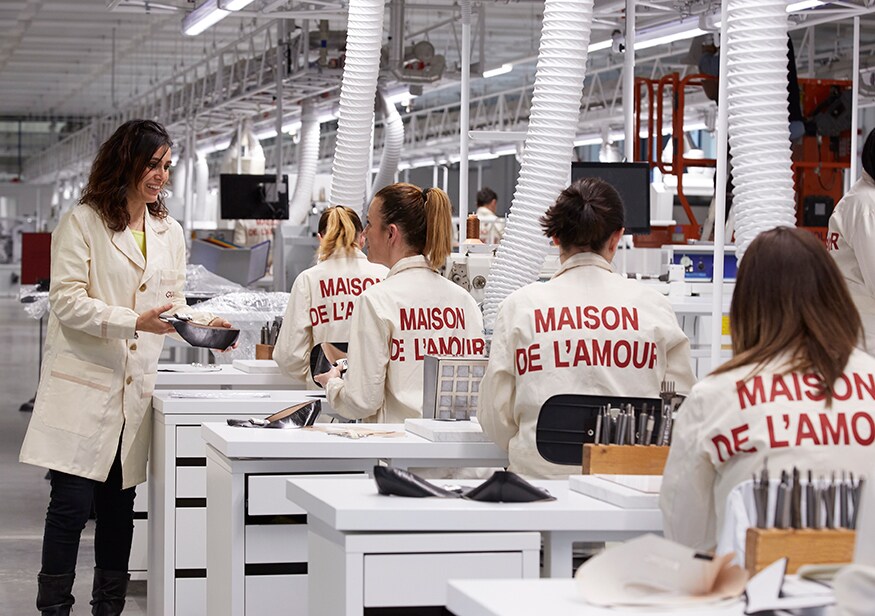
The brand continued to expand its offerings, including makeup collections and fine jewelry.
By 2019, Gucci’s sales had reached an impressive 9.6 billion euros.
In December 2020, Gucci entered the online market by launching stores on Tmall, thanks to an agreement between Kering and Alibaba.
The brand’s commitment to innovation and expansion remained evident, with new launches and collaborations marking its journey.
Changing Leadership and a New Direction
On November 23, 2022, Alessandro Michele stepped down from his role as creative director of Gucci, marking the end of an era. On January 28, 2023, Sabato de Sarno was announced as Gucci’s new creative director. De Sarno, with experience at Prada, Dolce & Gabbana, and Valentino, brings a fresh perspective to the brand’s future.
As Gucci continues to evolve, its story remains a testament to reinvention, innovation, and its enduring position as a symbol of luxury and style.
Also Read: Creating Magic: The Disney Success Story Unveiled
To read more content like this, subscribe to our newsletter
